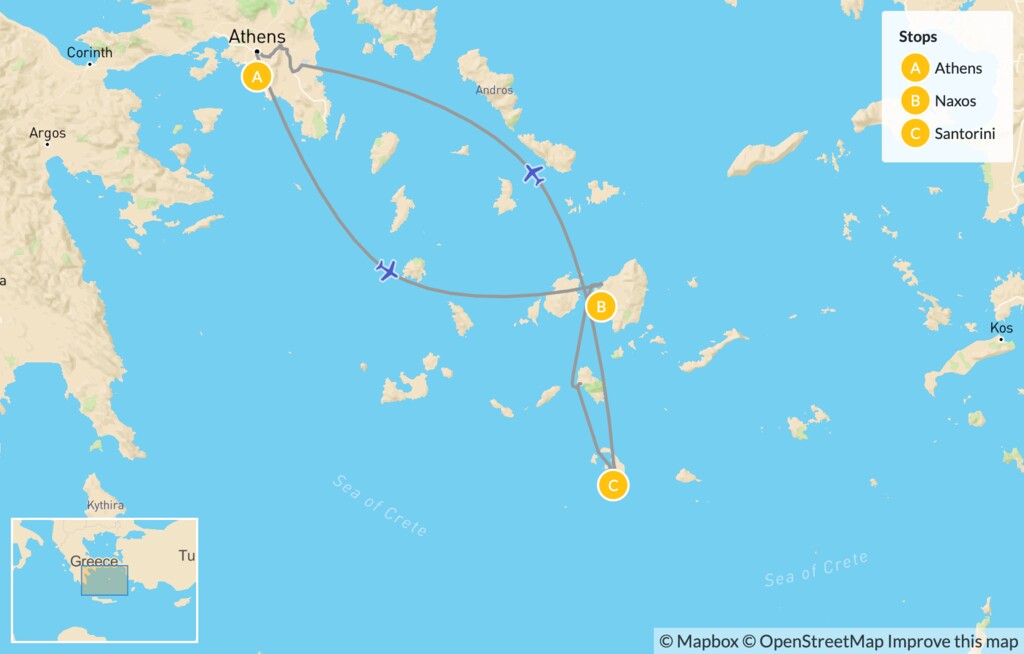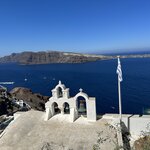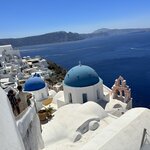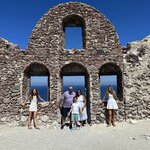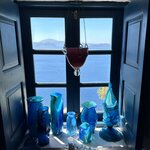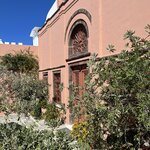Highlights
- Listen to mythological tales atop the Acropolis
- Seek the oracle on a hike through Delphi
- Learn about Cycladic island cuisine on Naxos
- Watch the sunset on Santorini's famous caldera
Brief Itinerary
| Day | Highlights | Overnight |
|---|---|---|
| Day 1 | Arrive in Athens & Explore the City Parks | Athens |
| Day 2 | Athens Mythology Tour, Cooking Class & Evening in Plaka | Athens |
| Day 3 | Day Trip to Delphi & Corycean Grotto | Athens |
| Day 4 | Athens to Naxos | Naxos |
| Day 5 | Naxos Beaches, Food & Culture | Naxos |
| Day 6 | Day Trip to Delos & Mykonos by Boat | Naxos |
| Day 7 | Naxos to Santorini | Santorini |
| Day 8 | Oia Walking Tour & Beach Day | Santorini |
| Day 9 | Fishing Trip & Lost Atlantis for Families | Santorini |
| Day 10 | Santorini to Athens & Depart |
Detailed Itinerary
Day 1: Arrive in Athens & Explore the City Parks

Trade the bustling markets and ancient sites of Athens for a little reprieve in nature to help you settle in. Greece's lively capital is home to its fair share of peaceful and verdant parks and hills, all reachable within the city center.
From the hill atop Mt. Lycabettus, you'll enjoy sweeping, panoramic views of the ancient city, including the famed Acropolis Hill and the Saronic Gulf. Avoid the long lines at the funicular and follow one of the innumerable paths to the top. Along the way, you'll pass several viewpoints and pockets of green to enjoy a rest, picnic, or game of frisbee. The park feels like a different world despite being in the middle of buzzy Athens.
Day 2: Athens Mythology Tour, Cooking Class & Evening in Plaka

Explore the Acropolis and Ancient Agora with your family, learning about Greek mythology and history while enjoying kid-friendly activities and panoramic views of the city.
After meeting your guide, you'll start your walk up to Acropolis Hill, the "Sacred Rock" that defines Athens. You'll visit all its popular monuments, including the Parthenon, Theater of Dionysus, Temple of Athena Nike, and Temple of Erechtheion. Listen to the legends of the Greek pantheon, such as the mighty Zeus, Athena (goddess of wisdom), Poseidon (god of the sea), Dionysus (god of wine and theater), and more. The stories will keep kids entertained and asking questions.
After enjoying Acropolis Hill and learning the city's secrets, you'll walk down to the ancient marketplace, the Agora. Socrates and Plato hosted many political and philosophical discussions on this plaza. At the end of the tour, enjoy a family activity inside the ancient Agora, using all your newfound knowledge about Greek gods, goddesses, and heroes.
Next up, a family-friendly cooking class will teach you how to make some of Greece's most beloved delicacies. Set within an organic grocery store filled with Greek products, you'll learn about important local favorites, treats, and ingredients from across the country.
Before you begin, your host will share the history, tradition, and cultural importance of Greek cuisine. Together, you'll discover some of the most authentic Greek recipes and secrets as you prepare your meal. This hands-on session produces a traditional Greek meal with horiatiki (Greek salad), gemista (stuffed vegetables), a delicious milk pie from Mani (Mani galatopita), and more.
When finished, you'll enjoy the fruits of your labor and eat together like locals, the key principle of well-known Greek hospitality. Greeks love to welcome visitors into the healthy and flavorful world of the Mediterranean diet. Chat with your host over a glass of Greek wine, beer, or ouzo (kids can enjoy juice) and relax.
In the evening, head out for a walk through the Plaka neighborhood, the oldest and the most charming neighborhood of the city and ideal for an evening stroll. Walk in the pedestrian part of the city and try to trace the remnants of the city’s various stages at spots like the Roman Agora, the Old University, the Tower and Bath House of the Winds, the Benizelos Mansion, the Monument of Lysicrates, and all the lovely Byzantine churches. If you have the time, stop in at one of the two children’s museums, the Museum of Greek Children’s Art and the School Life & Education Museum.
Chat with a local specialist who can help organize your trip.
Day 3: Day Trip to Delphi & Corycean Grotto

After about two hours, you'll arrive at the area of Delphi and enjoy a moderate hike to the Corycean Grotto, dedicated to the god Pan. Accompanied by your expert guide, walk down an ancient footpath once used by worshippers of Pan, passing through olive groves with views of the Corinthian Gulf and the Peloponnese mountains. The surrounding landscape will help you understand why Delphi stood as the cultural and religious center of the Hellenic world for centuries.
Rest your feet and enjoy a snack before heading to the ancient archaeological site of Delphi. Here, you'll follow your guide through the sprawling property, stopping at all the must-see sites. Visit the Treasury of the Athenians, the Temple of Apollo, and the expansive, open-air theater. Your guide will share historical information about these monuments built in the 4th century BCE. You'll also visit the Polygonal Wall, built in the 6th century BCE to support the terrace where the Temple of Apollo stands.
Next, head to the museum, where your guide will reveal various artifacts, including the bronze Charioteer of Delphi, the haunting Sphinx of Naxos, and what might be the very first recorded notation of a melody. You'll also visit the old town and try to meet the last bellmaker in Greece before heading back to Athens.
Day 4: Athens to Naxos

Head into the islands today as you make your way to Naxos, the Cyclades' largest island.
After your flight from the mainland, the evening is yours to explore the dusky beauty of Naxos town (Chora). Start by exploring the narrow streets with their distinctive white and blue accents, admiring the Cycladic architecture. The unique positioning of the buildings protects from the heat and wind, and historically from external threats.
You'll find hidden alleyways and courtyards, all exposing the daily routines of the locals. Overlooking the town of Naxos and atop a small hill is the Venetian Castle, or the Kastro as the locals call it. All the narrow, twisting streets seem to slowly pass through time, helping you travel back to the Venetian era as you ascend the castle.
Then, make your way down to the seafront promenade for a totally different look and feel. The waterfront is far more lively and cosmopolitan, connecting the island to the rest of the Cyclades. Stop for snacks or drinks while you wander, and don't miss the famous local cheeses—the island is one of the few places in Greece that produces cheese using cow milk. Parents can also sip on the locals' favorite liqueur, kitron.
As the sun starts to set, walk across a short causeway to the Portara, the Temple of Apollo's entryway. This is one of the best places to watch the horizon change colors and relax as dusk turns to night. The Portara is the only part of the temple that still stands today, proudly enduring on the islet of Palatia.
Day 5: Naxos Beaches, Food & Culture

Featuring smaller crowds than its Cycladic neighbors, Naxos makes it easy to find your own slice of paradise on its famed beaches. Whether you're looking for privacy, rustic beauty, or a lively scene, you can find it on Naxos.
Depending on your preferences, you have a few options for Naxos beaches.
- Agios Georgios. This beach is the closest option to the main town, offering easy access and proximity to cafes, restaurants, and shops. Generally filled with families, it's the perfect option for enjoying shallow waters and a bit more energy. An Aqua Fun Park for kids can be found in Stelida.
- Agia Anna & Agios Prokopios. Both beaches feature sweeping sandy banks and offer plenty of amenities, including chairs, umbrellas, and tavernas. With a lengthy shoreline, you can easily claim a spot and enjoy privacy. The shallow water makes them an excellent option for families and snorkeling. You can find pedal boats to rent.
- Plaka & Apollonas. Like Agia Anna and Agios Prokopios, these two beaches offer amenities, privacy, and family-friendly waters. However, they're slightly less crowded and provide a quieter reprieve.
If your family is on the sportier side, there are options for beginners' classes in kitesurfing, windsurfing, and scuba diving as well.
Once you've soaked up sufficient sun, head out on a private tour to explore Naxian culture and food. The countryside of Naxos island has some of the best local produce and food in the Cyclades.
You'll start in the charming village of Kaloxylos, where you'll visit a local home. Chat with your hosts over the age-old tradition of Greek coffee and dessert and learn about traditional Naxian cuisine and daily life in rural Naxos. Join your host on a stroll through the village, tasting a few items and collecting ingredients for a typical Naxian dish.
Next, make your way through the other villages, which include Filoti, Apeiranthos, and Chalki. Enjoy a local cheese tasting and sample traditional recipes as you stroll through the narrow streets. Meet with local producers and learn more about what makes Naxian produce, olive oil, meats, and dairy products so significant to the whole of Greece.
You'll end your tour with a visit to a kitron liquor distillery to see its production in action and taste the traditional spirit of Naxos.
Day 6: Day Trip to Delos & Mykonos by Boat

Enjoy a day cruise to the picturesque islands of Mykonos and Delos. In the morning, you'll board your boat and relax as you glide through the sea toward Delos, a sacred island once the center of the Cyclades. Although currently uninhabited, the island one of the most important and impressive archaeological sites in Greece.
Delos played a significant role in the ancient world of the Cyclades. It's the birthplace of two Greek gods, Apollo and Artemis, and it became home to the first multicultural civilization in the world. You'll walk around the archeological site with a dedicated guide, learning about the island's fascinating history, culture, and why it was such an important trade center.
You'll weave through the foundations of prehistoric mansions, temples, and landmarks, such as the Terrace of the Lions. Afterward, pop into the island museum, which hosts an extensive collection of small artifacts and frescoes. When you're finished, you'll head back to the boat and make your way toward lively Mykonos.
As an active cosmopolitan hub, Mykonos couldn't be more different from Delos. The island is known for its blue and white cubic houses, narrow streets, and the picture-perfect Little Venice neighborhood along the waterfront. You'll also find Greece's famous windmills in Mykonos, the perfect place to capture the essence of the Cyclades. Enjoy plenty of free time to roam around the main town, exploring its streets, finding viewpoints, and relaxing at one of its cafes.
Day 7: Naxos to Santorini

Take a 1.5-hour high-speed ferry from Naxos to the famous cliffs of Santorini.
There's nothing like a Santorini sunset, as the island's viewpoints are some of the Cyclades' best. It isn't easy, however, to find a spot without extreme crowds. Get off the beaten path and discover the hidden go-to's so you can have the views mostly to yourself.
Perhaps the best way to enjoy the caldera views is along the Fira to Oia Walking Path. This route runs underneath the island's main road, offering a peaceful and quiet stroll while enjoying endless, uninterrupted views. You don't have to trek the entire trail to reap the benefits; a great entry point is at the Pantheon between Imerovigli and Oia. From here, enjoy a short, easy, and mostly downhill walk with excellent views.
One of the island's best spots for sunset is Skaros Rock, an impressive rock formation that juts out into the sea. The views require a short hike from the trailhead at Imerovigli, so wear some sturdy shoes. The terrain is rocky, so pay attention to where you step, especially when returning from sunset after dark.
If you're interested in savoring those perfect panoramic views of Santorini without the crowds, visit the Monastery of Prophet Elias. This is the highest point on the island, so you'll get a 360-degree view of the sea, rocky cliffs, and white-washed villages. Before making the drive, take a peek at the weather report, as it tends to get a little foggy at the top.
To catch views of Santorini's entire crescent-shaped caldera, you can hop on a quick 30-minute ferry to Thirassia (departing from Ammoudi). Thirassia is one of the remote volcanic islands set within the crater. To get the best views, leave the small port and walk up to the village. On the way, you’ll enjoy scenes of the entire caldera from a unique vantage point.
Day 8: Oia Walking Tour & Beach Day
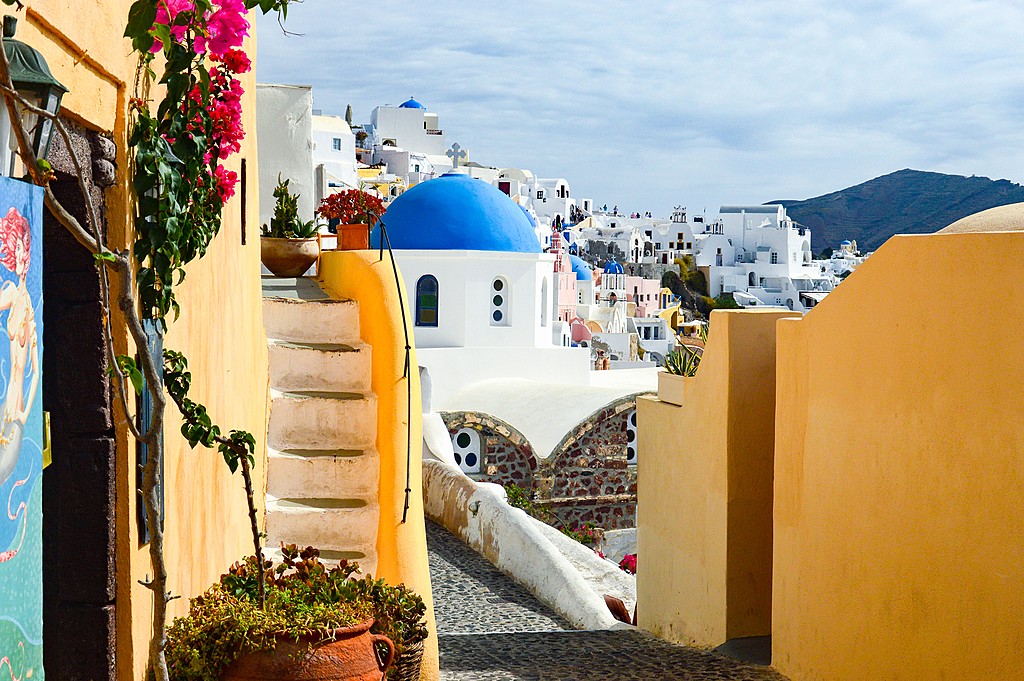
Explore Oia, Santorini's picture-perfect village, with a private, local guide. Dramatically perched atop the cliffs of the caldera, this scenic town contrasts famously against its natural surroundings. Rusty rocks and azure-blue waves complement its pastel cave houses, whitewashed facades, and colorful harbor. Enjoy strolling through the charming streets while admiring the views over the caldera and volcanic islands.
As you walk through the main streets and back alleyways of this enchanting village, your guide will make several stops to point out exceptional viewpoints and interesting island history. Listen to stories about Oia's culture and heritage, then discover the picturesque fishing harbor of Ammoudi. You'll descend 300 steps along the caldera's rim, ending at a small port untouched by time.
Afterward, it's time to hit the beach. Most of the island's banks feature dark volcanic sand in black and red hues, contrasting perfectly with the deep blue sea and whitewashed villages. Enjoy relaxing, swimming, or snorkeling in the surreal scenery, but don't forget your sandals or water shoes, as the dark sand becomes incredibly hot in the midday sunshine.
Santorini is home to several beach options. For families, try Kamari Beach, the most upscale and touristy of Santorini's beach towns with a fun and family-friendly vibe. The beach's black sand and pebbles stretch for over three miles, providing numerous restaurants, cafes, and bars. You'll also find places to rent jet skis or snorkeling and scuba diving equipment.
For somewhere a little less busy, Monolithos Beach is home to Santorini's best sand and the most family-friendly beach on the island. It offers a quiet and relaxed vibe with a small cluster of hotels and restaurants. You can rent umbrellas and loungers and enjoy watching the white-capped waves flow onto the shore.
Day 9: Fishing Trip & Lost Atlantis for Families

Experience Santorini's famed seafood aboard a traditional fishing boat while eating the catch-of-the-day for lunch or dinner with a fishing trip that can take place either first thing in the morning or in the evening. You'll start your excursion at Vlychada Marina. As you head for one of the deepest and most diverse spots in the Aegean Sea, your boat will release nets and creels in hopes of catching shrimp and octopus.
Your expert guide will teach you about the island's traditional fishing methods and help you get acquainted with your equipment. After learning a few basic techniques, you'll try your luck in the water. Whatever the ship catches, you'll enjoy for a meal!
After fishing, you'll dock at a gentle harbor where the crew will prepare your seafood. While you wait, enjoy swimming or snorkeling in the sea. If you haven't snorkeled before, your guide is happy to help you learn some diving and breathing techniques.
If you choose to take an evening trip, after dinner, you'll return to the open sea and watch a famous Santorini sunset. Enjoy views of the caldera as the sun melts in the sea before returning to Vlychada.
Before or after your time on the water, depending on how you choose to schedule your day, learn the story of Lost Atlantis. Live the myth at the new experiential museum in Santorini, the only museum about Lost Atlantis in the world. You can learn about the myth of Atlantis, how it is connected to Santorini, experience its destruction, and explore multiple digital installations.
Then continue to the possible inspiration behind the legend at Akrotiri, one of the most significant prehistoric settlements of the Aegean Sea. This archaeological site features an ancient city preserved by volcanic ash for thousands of years. You'll walk through the city's remarkably preserved ruins and learn why this site played such an essential economic role. Stroll amongst the ancient walls of the houses and learn what the inhabitants did each time the volcano erupted, how they took their ships out to sea only to return and rebuild their settlement from scratch.
Day 10: Santorini to Athens & Depart



